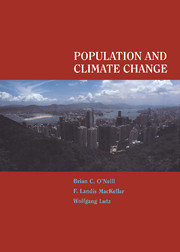Book contents
- Frontmatter
- Contents
- Foreword
- Preface
- Authors and Contributors
- Acknowledgments
- PART I
- PART II
- 4 Population and Greenhouse Gas Emissions
- 5 Population and Adaptation: Agriculture, Health, and Environmental Security
- 6 Population and Climate Change: Policy Implications
- Appendix I Fertility and Mortality Assumptions for IIASA Population Projections
- Appendix II Household-level Economies of Scale in Energy Consumption
- Appendix III Population in Major Climate Change Assessment Models
- References
- Index
4 - Population and Greenhouse Gas Emissions
Published online by Cambridge University Press: 23 December 2009
- Frontmatter
- Contents
- Foreword
- Preface
- Authors and Contributors
- Acknowledgments
- PART I
- PART II
- 4 Population and Greenhouse Gas Emissions
- 5 Population and Adaptation: Agriculture, Health, and Environmental Security
- 6 Population and Climate Change: Policy Implications
- Appendix I Fertility and Mortality Assumptions for IIASA Population Projections
- Appendix II Household-level Economies of Scale in Energy Consumption
- Appendix III Population in Major Climate Change Assessment Models
- References
- Index
Summary
As discussed in Chapter 1, if greenhouse gas (GHG) emissions are not constrained, the global average temperature is likely to rise 1–3.5 degrees Celsius (°C) by 2100. About half that range is due to uncertainty in the future unconstrained emissions path (i.e., assuming no policies aimed at reducing emissions are put in place), and the other half is due to uncertainty in the response of the climate system. Future emissions are likely to be an even more important determinant of future climate change, however, since the range of potential emission paths is considerably widened by taking into account policies that could reduce emission rates.
Broadly speaking, demographic change, changes in economic output, and changes in the GHG intensity of the global economy are the forces driving GHG emissions. Each of these is, in turn, influenced by a number of important indirect variables. Regarding the role of demographic change, Chapter 2 demonstrates that a wide range of population paths is possible and that the primary determinant of future population size and structure will be trends in fertility rates.
Taken together, these observations suggest that by slowing population growth, policies that tend to reduce fertility could contribute to reducing emissions and averting climate change. In this chapter we address the questions of how much such policies might reduce GHG emissions and how these reductions would compare with reductions achievable through other means. We discuss the human activities that give rise to GHG emissions and review studies that have used demographic impact identities based on the Impact–Population–Affluence–Technology (I=PAT) equation to apportion responsibility for emission trends among driving forces.
- Type
- Chapter
- Information
- Population and Climate Change , pp. 113 - 142Publisher: Cambridge University PressPrint publication year: 2000



